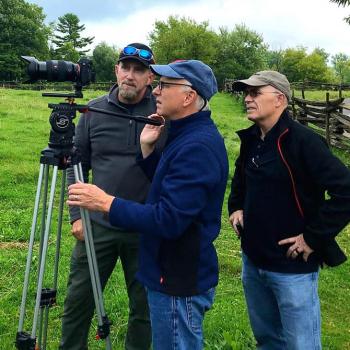
The name of the island hearkens back to the day when Aswan was a major center of the Egyptian ivory trade with sub-Saharan Africa.
***
As part of my on-going effort to remind people of the rich variety of offerings that has been provided in Interpreter: A Journal of Latter-day Saint Faith and Scholarship — or to call it to their attention in the first place — I provide here a few more links from a previous volume of the journal:
Daniel C. Peterson, “Compassion as the Heart of the Gospel”
Abstract: The Greek philosopher Aristotle, clearly one of the world’s great geniuses, created the concept of the “unmoved mover,” which moves “other things, but is, itself, unmoved by anything else.” This label became the standard Jewish, Christian, and Muslim description of an impersonal God — a God without body, parts or passions — a concept that has, for nearly 20 centuries, dominated western theology, philosophy, and science. The problem for thinkers in these religious traditions is that the God depicted in the Bible and the Qur’an is plainly personal. A careful review of the Bible and modern scripture reveals a “compassionate, feeling” God. Numerous scriptures confirm that God, in fact, “feels more deeply than we can even begin to imagine.”
Neal Rappleye, “Revisiting “Sariah” at Elephantine”
Abstract: Jeffrey R. Chadwick has previously called attention to the name ŚRYH (Seraiah/Sariah) as a Hebrew woman’s name in the Jewish community at Elephantine. Paul Y. Hoskisson, however, felt this evidence was not definitive because part of the text was missing and had to be restored. Now a more recently published ostracon from Elephantine, which contains a sure attestation of the name ŚRYH as a woman’s name without the need of restoration, satisfies Hoskisson’s call for more definitive evidence and makes it more likely that the name is correctly restored on the papyrus first noticed by Chadwick. The appearance of the name Seraiah/Sariah as a woman’s name exclusively in the Book of Mormon and at Elephantine is made even more interesting since both communities have their roots in northern Israel, ca. the eighth–seventh centuries BCE.
Clifford P. Jones, “The Record of My Father”
Abstract: In 1 Nephi 1:16–17, Nephi tells us he is abridging “the record of my father.” The specific words Nephi uses in his writings form several basic but important patterns and features used repeatedly by Nephi and also by other Book of Mormon writers. These patterns and features provide context that appears to indicate that Nephi’s abridgment of Lehi’s record is the third-person account found in 1 Nephi 1:4 through 2:15 and that Nephi’s first-person account of his own ministry begins in 1 Nephi 2:16.
S. Kent Brown, “The First Easter”
Abstract: Scriptural accounts are rife with information about the import of the first Easter. Understanding the events of the week before the death and resurrection of Christ can help us appreciate the words of the witnesses as well as the importance of these events in our lives.
George L. Mitton, “The Crucifixion as a Mockery, Witness, and Warning of the Judgment”
Abstract: In its action, setting, and arrangement, the crucifixion may be viewed as a stark mockery of the final judgment scene. This article provides a brief review of the relevant scriptures, considered together with some related apocryphal and other early Christian writings of interest in regard to the crucifixion. These sources point to the interpretation that the gospel writers saw in the crucifixion a striking symbolism that can provide a strong reminder, witness, and warning of the coming judgment. The Lord is seen in the crucifixion as at once representing His humility in submitting Himself to be judged and, conversely, His authority and power to be the judge of all. The crucifixion signifies the concept of a reciprocal or two-way judgment, as emphasized in the Book of Mormon, where mankind first judges the Lord, and later are to be judged accordingly by Him in return.
Steven T. Densley, Jr., “Procedural Violations in the Trial of the Woman Taken in Adultery”
Abstract: The story in John 8 of the woman taken in adultery is sometimes used to argue that Jesus was lenient toward sin and that we should be too. However, when placed in its broader context, we can see the story is not one in which Christ shows indifference or contempt for the law, but rather utmost respect for it.
Abstract: Dr. Michael Coe is a prominent Mesoamerican scholar and author of a synthesis and review of ancient Mesoamerican Indian cultures entitled The Maya.1 Dr. Coe is also a prominent skeptic of the Book of Mormon. However, there is in his book strong evidence that favors the Book of Mormon, which Dr. Coe has not taken into account. This article analyzes that evidence, using Bayesian statistics. We apply a strongly skeptical prior assumption that the Book of Mormon “has little to do with early Indian cultures,” as Dr. Coe claims. We then compare 131 separate positive correspondences or points of evidence between the Book of Mormon and Dr. Coe’s book. We also analyze negative points of evidence between the Book of Mormon and The Maya, between the Book of Mormon and a 1973 Dialogue article written by Dr. Coe, and between the Book of Mormon and a series of Mormon Stories podcast interviews given by Dr. Coe to Dr. John Dehlin. After using the Bayesian methodology to analyze both positive and negative correspondences, we reach an enormously stronger and very positive conclusion. There is overwhelming evidence that the Book of Mormon has physical, political, geographical, religious, military, technological, and cultural roots in ancient Mesoamerica. As a control, we have also analyzed two other books dealing with ancient American Indians: View of the Hebrews and Manuscript Found. We compare both books with The Maya using the same statistical methodology and demonstrate that this methodology leads to rational conclusions about whether or not such books describe peoples and places similar to those described in The Maya.
Nathan J. Arp, “Joseph Knew First: Moses, the Egyptian Son”
Abstract: After about 1500 years of slumber, ancient Egyptian was brought back to life in the early 19th century, when scholars deciphered hieroglyphs. This revolutionary success opened the door to a reevaluation of history from the viewpoint of ancient Egypt. In the wake of this new knowledge, the first scholar posited the idea in 1849 that the name of Moses stemmed from the Egyptian word for child. Subsequently, this idea was refined, and currently the majority of scholars believe Moses’s name comes from the Egyptian verb “to beget,” which is also the root for the Egyptian word for child, or in the case of a male child, a “son.” Before this discovery and certainly before a scholarly consensus formed on the Egyptian etymology of the name of Moses, Joseph Smith restored a prophecy from the patriarch Joseph that played upon the name of Moses and its yet to be discovered Egyptian meaning of “son.” This article explores the implications of this overt Egyptian pun and its role as a key thematic element in the restored narratives in the Book of Moses.












